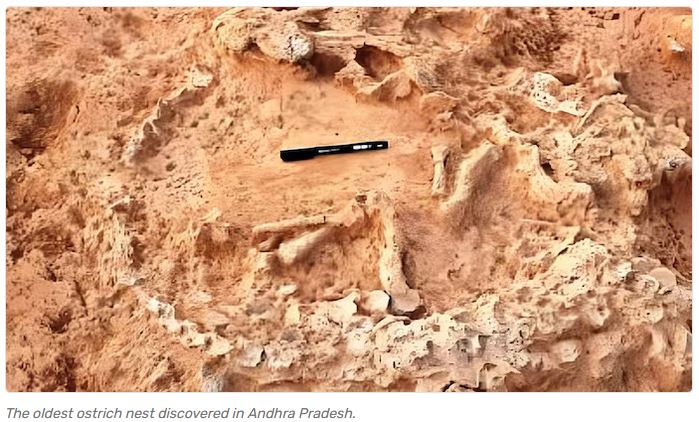From UPSC perspective, the following things are important :
Prelims level: Megafauna, Archaeological evidence of Ostrichs in India

Why in the News?
Archaeologists have discovered a 41,000-year-old ostrich nest in Prakasam, Andhra Pradesh.
Prehistoric Ostrich Nest: Details of the Discovery
- The nest, identified as the world’s oldest known ostrich nest, measures 9-10 feet in width.
- The nest was once home to 9-11 eggs but was capable of holding 30-40 eggs at a time.
- Ostriches are mega omnivores, weighing between 90 and 140 kg and standing seven to nine feet tall.
What are Megafauna?
- Megafauna generally refers to animals weighing more than 50 kg, though scientific definitions vary.
- The term was first used by Alfred Russel Wallace in his 1876 book, “The Geographical Distribution of Animals.”
- Megafauna can be classified into:
- Megaherbivores (plant-eaters),
- Megacarnivores (meat-eaters), and
- Megaomnivores (who eat both plants and meat).
Historical Evidence of Megafauna
- Early Documentation: Richard Lydekker in 1884 presented the earliest documented evidence of ostriches in the subcontinent, identifying the extinct Struthio asiaticus in the Dhok Pathan deposits in Upper Siwalik Hills, present-day Pakistan.
- Discoveries in Maharashtra: Archaeologist S A Sali in 1989 reported ostrich eggshell beads and engraved pieces dating back to 50,000–40,000 years ago at Patne, Maharashtra.
- CCMB Research in 2017: Researchers at the Centre for Cellular and Molecular Biology (CCMB) in Hyderabad established the presence of ostriches in Rajasthan, Madhya Pradesh, and Gujarat 25,000 years ago.
Broader Implications and Studies
- Biogeographical Dispersion: The presence of ostriches in India is attributed to bio-geographical dispersion from the continental drifting of Gondwanaland.
- Late Quaternary Extinctions: The study, titled ‘Late Quaternary extinctions in the Indian Subcontinent,’ established that the disappearance of large animals began around 30,000 years ago, coinciding with the arrival of humans.
- Co-Evolution Hypothesis: The study supports the hypothesis that fauna and their resilience to extinction resulted from coevolution with hominins, with geographic isolation and abiotic factors accelerating extinction.
PYQ:[2018] The term “sixth mass extinction/sixth extinction” is often mentioned in the news in the context of the discussion of: (a) Widespread monoculture practices in agriculture and large-scale commercial farming with indiscriminate use of chemicals in many parts of the world that may result in the loss of good native ecosystems. (b) Fears of a possible collision of a meteorite with the Earth in the near future in the manner it happened 65 million years ago that caused the mass extinction of many species including those of dinosaurs. (c) Large-scale cultivation of genetically modified crops in many parts of the world and promoting their cultivation in other parts of the world which may cause the disappearance of good native crop plants and the loss of food biodiversity. (d) Mankind’s over-exploitation/misuse of natural resources, fragmentation/loss of natural habitats, destruction of ecosystems, pollution and global climate change. |
Get an IAS/IPS ranker as your 1: 1 personal mentor for UPSC 2024
